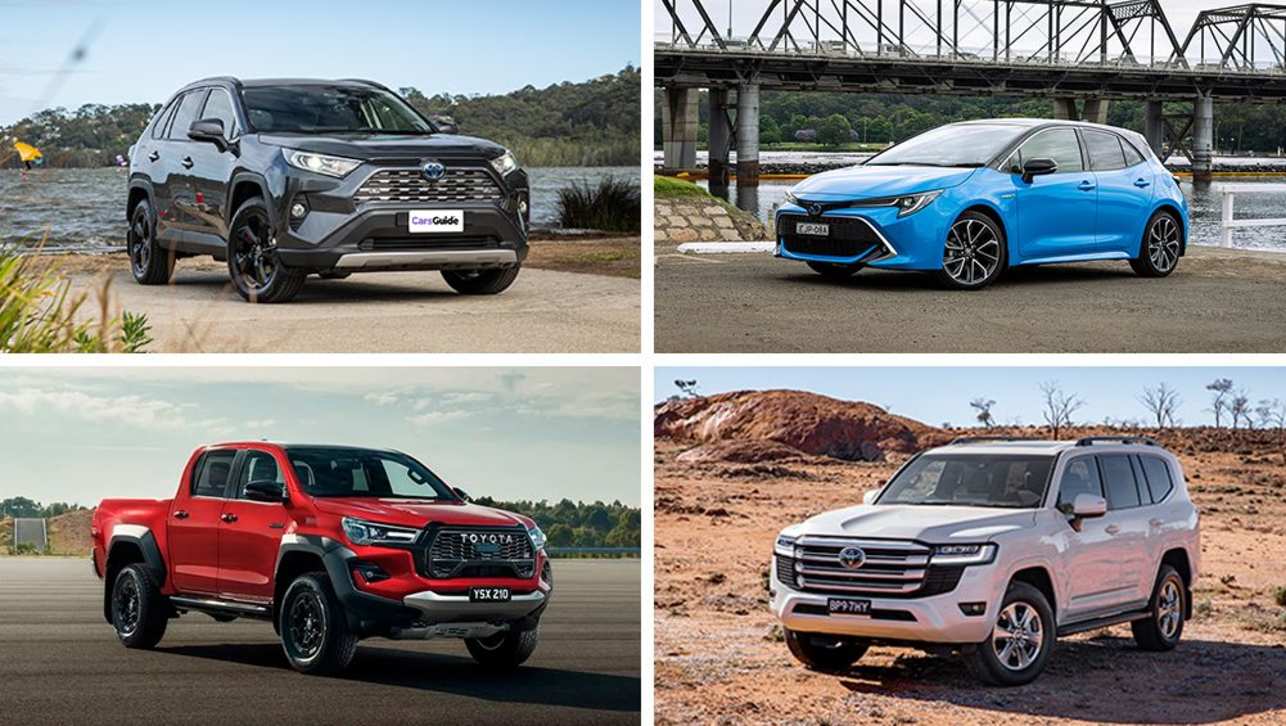Toyota Australia has long held a dominant grip on the Australian new-car market, having wrestled control from home-grown brands like Holden and Ford.
However, I’m betting that’s all going to change in the next five years thanks to a confluence of events in multiple segments that will see the big T brand bleed sales to the likes of Hyundai, Kia, MG and BYD.
But before I get too ahead of myself, first let’s look at how Toyota rose to the top of the competitive Australian market.
It was 1992 when Toyota first snatched the top-selling crown, but not until 2003 when it started its current 20-year-long hot streak when it outsold Holden to the tune of 186,370 units to 175,412.
The VY Commodore was still the most popular model with 86,553 sales in 2003, while HiLux managed to move just 25,883 units.
Commodore continued to sell well though, taking out top spot all the way until 2010, but the Corolla and HiLux were already nipping at its heels.
As well, a shift away from large, inefficient, rear-drive sedans saw Holden (and Ford) sales decline in the coming years as customers started to clue in on three big letters – S, U and V.
.jpg)
And Toyota was, naturally, in a strong position to capitalise with the already-established RAV4, Kluger, LandCruiser and Prado.
In 2011 and 2012, the box-fresh Mazda3 was the best-selling model, which was then usurped by the Corolla for the next three years.
And it was in 2013 when the announcement came from Ford and Holden (and in early 2014, Toyota) that Australian vehicle manufacturing would cease in from 2016.
The year Ford Australia stopped making the Falcon and Territory was also the first year the HiLux rose to the top, a position it has held since and looks to take out again in 2023.

In fact, in 2016, Toyota’s 209,610 sales were more than Holden and Ford’s combined that year, representing a gigantic 17.8 per cent slice of the market.
Ultimately the decision in 2013 to discontinue local car manufacturing would see Holden and Ford try and pivot interest for its Commodore and Falcon respectively to imported models like the ZB Commodore and Mondeo, as well as the Colorado and Ranger utes.
But Toyota didn’t need to do that, as its HiLux was already a top seller.
Toyota was in the right position at the right time to capitalise on all those lost fleet contracts too, swelling their numbers to a third-best-ever high of 231,050 units in 2022 (behind 2008’s 238,983 and 2007’s 236,647 figures).
And it’s a grip Toyota Australia has maintained to this day, largely thanks to the wide assortment of products across all popular segments at a comparatively affordable price.
Seriously, whatever class of car you think you need, Toyota will have it.
From the Yaris hatchback to the Camry sedan, the stylish C-HR crossover to the LandCruiser off-road SUV, and even the sporty GR86 and Supra – Toyota fields a competitor in all mainstream vehicle segments to suit all needs.
This isn’t even to mention the strongest dealer network in the country, meaning many rural buyers will naturally flock to a Toyota model as service centres and parts are easier to source.
So how do you pry open such an iron grip?
The answer might be in EVs – an area where Toyota has struggled to find a footing (despite its reputation for hybrids), and with its first mass-market electric car, the bZ4X delayed with question marks over advertised range and reliability, it leaves the door open for another brand to pounce similar to the changing of the guard from Holden to Toyota all those years ago.
Or maybe it’s in the affordable ‘first car’ space. Toyota’s Yaris used to be marketed as a great first-car option starting well below $15,000, but has now risen to an entry point of $24,800 before on-road costs.
We all know that if you have a great first-car buying experience, you are more likely to stick with the same brand as your needs and income grow, so is Toyota losing out on making that crucial first impression?
Toyota Australia is also currently suffering through stock shortages that mean customers are facing wait times of at least six months for some models, while popular nameplates blow out to more than a year.

And, let's be honest, these aren't exactly emotional purchases, so a customer faced with an extended wait when they need/want a new car will just shop elsewhere and go to a brand that has something ready to go sooner rather than later.
So, with these thoughts in mind, who is the prime candidate to take down Toyota? The obvious answer is Kia.
Kia has already established itself as a strong EV player, with the Niro, EV6 and soon-to-launch EV9 making waves, turning heads and stealing headlines – and there’s more electric cars to come like the EV5 mid-size SUV set to launch in one of Australia's most popular segments.
Kia Australia has also kept the flame alive for budget-conscious buyers thanks to its pint-sized Picanto and reasonably-priced Rio.
The South Korean brand has also managed to diversify its line-up with more SUV offerings like the Stonic and Seltos in recent years, while also maintaining a presence in the people mover space with the popular Carnival, giving customers a wide breadth of product choice under one stable.
.jpg)
And Kia's supply is currently plentiful, meaning there is a variety of vehicles that are ready to be delivered into customer's hands now.
Sound familiar?
Kia is a brand that is established, well known and popular in Australia, making all the right moves.
But there’s a crucial missing player in Kia’s move up the ranks – it currently lacks a dual-cab ute.
That’s all going to change around 2025 however, with the so-called Tasman set to launch to steal the thunder away from the Toyota HiLux and Ford Ranger.
Don’t get me wrong, this model will not debut as the best-selling car in the country, but what it will do is give buyers another choice in a competitive market.
And choice, inevitably, means Kia will manage to steal sales away from some rivals.
.jpg)
Keep in mind Kia also offers a seven-year warranty, outstripping the five years on offer by Toyota – and if you are a small business owner or fleet manager, wouldn’t that push you towards team Kia?
But the biggest Achilles heel for Toyota might be its push upmarket.
I mentioned the Yaris hatchback had now moved so upstream its arguably out of reach for most first-car buyers, but increase in price is happening across the board.
The first-generation Toyota 86 launched in 2012 at $29,990, and the second-gen, 2022 model is $43,240.
The Kluger, RAV4, Corolla, Camry and LandCruiser are now all more expensive than ever before, while the next-generation Prado due in 2024 will no doubt march upmarket from its current $62,830 starting price due to advancements in safety features, in-cabin technology and a more complex 48-volt turbo-diesel engine.
The chinks in Toyota’s armour are starting to show, but it’s still going to take a monumental push to move the brand from the number one spot.
All I’m saying is, if anyone can do it, I’m betting on Kia.


-2.jpg)





.jpg)

.jpg)
.jpg)




.jpg)
.jpg)

.jpg)


.jpg)
.jpg)
.jpg)
.jpg)

.jpg)


.jpg)

Comments